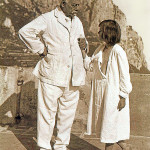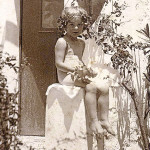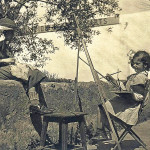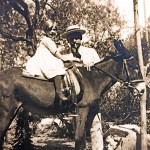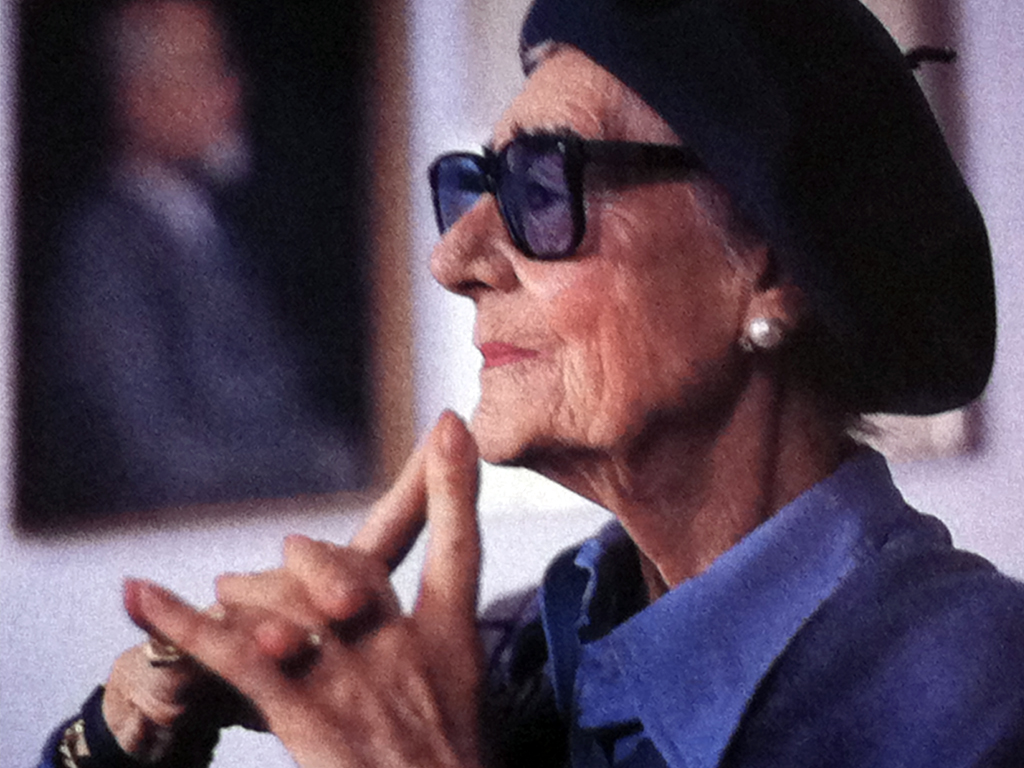
Donna Laetitia
Raffinata, eclettica, cosmopolita con profonde radici capresi. E a Capri visse a lungo dipingendo, disegnando e lavorando a piccolo punto. Ma soprattutto guidando con passione il Centro Cerio fondato dal padre Edwin
di Carmelina Fiorentino | foto Archivio F. Alvarez de Toledo
Contessa Cerio. Così mi fu presentata alla fine degli anni Ottanta, nella Biblioteca del Centro Caprense. Quella figura alta e slanciata, avvolta in un’ampia e fluttuante gonna di seta color crema, con il cappello di paglia adornato da una fascia della stessa seta, il bastone dall’impugnatura preziosa, mi fece pensare subito che quel misto di raffinatezza, distanza ed eleganza dovesse essere una caratteristica familiare: gli anziani capresi così ricordavano il padre Edwin.
Laetitia era nata a Buenos Aires nel 1908 da Helena Hosmann, fotografa che Edwin aveva conosciuto quando, in Argentina, progettava la ferrovia transandina per Alfred Krupp. Le assomigliava molto sebbene di carnagione e capigliatura più chiari della “mora” Helena, i tratti del viso richiamavano molto quelli della mamma. Aveva cominciato a dipingere e disegnare da bambina, sotto la guida attenta e affettuosa degli artisti di famiglia. Perfezionò poi il suo talento frequentando l’Accademia d’Arte a Firenze, lezioni private da un notevole Baccio Maria Bacci, infine, ma in età adulta, la Art Students League di New York.
Nel 1932 Laetitia sposò Ramiro Alvarez de Toledo, affascinante rampollo di un’antica famiglia nobile napoletana; la cerimonia fu officiata nel Salone di Palazzo Cerio, monumentale e straordinario luogo che serba memoria di 700 anni di celebrazioni ed eventi, anche regali. Beatrice e Fernando, i due figli nati dal loro matrimonio, ebbero la rara fortuna di avere una madre che leggeva loro favole home made. Laetitia inventava le storie e, soprattutto, le illustrava con teneri disegni di animali fantastici che crescevano e si trasformavano col volgere delle pagine. In Argentina, dove negli anni Quaranta visse con loro, fu costumista per la Pampa Film e disegnò abiti per riviste di moda.
Cominciarono poi anni difficili: la morte dell’adorata piccola Beatrice e in seguito il divorzio segnarono Laetitia nella mente e nell’animo. L’affetto degli amici e la protezione del suo angelo custode terrestre, zia Mabel – moglie di Giorgio Cerio – fecero sì che Laetitia recuperasse forze e vitalità, anche grazie al suo buen retiro: Capri.
Sebbene l’isola fosse stata sempre una parte importante della sua vita, dal 1948 – anno in cui con Fernando vi si trasferì – Capri acquisì maggior peso nella vita di Laetitia. I paesaggi, i colori e i personaggi in cui s’imbatteva sull’isola furono fondamentali per la sua affermazione come artista internazionale, ma anche per la sua personalità. Tra lo studio a La Certosella – la villa su via Tragara che il padre le aveva regalato (trasformata poi in albergo) – e New York, Laetitia dipingeva e disegnava; organizzava e allestiva mostre personali e collettive in diverse città europee, negli Stati Uniti e a Capri, nella Sala d’arte libera del Centro Caprense. Si trattò di anni, artisticamente parlando, molto fecondi. Disegnò carte da parati e stoffe per svariate ditte tedesche anche se questo tipo di attività, per quanto ottimamente remunerata, non fu mai la sua preferita.
Frequentava quotidianamente, sia d’estate che d’inverno, La Canzone del Mare per le sue nuotate. Fu qui che strinse amicizia con lo stilista Emilio Pucci – che in quella baia incantata che è Marina Piccola aveva aperto una boutique – e iniziò a collaborare con la sua casa di moda. Tra le amicizie importanti di Laetitia non ci furono solo stilisti. Gracie Fields, ma soprattutto Graham Greene, Jorge Luis Borges, Piero Gadda Conti, Francis Steegmuller e la moglie Shirley Hazzard furono alcuni degli intellettuali italiani e stranieri che riempirono l’Album amicorum oltre che l’animo e l’intelletto di Laetitia.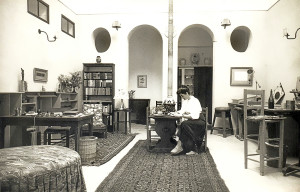
Nel 1962 Donna Laetitia assunse la presidenza del Centro Caprense Ignazio Cerio dopo che la morte del padre, Edwin Cerio, fondatore e presidente aveva lasciato l’Ente Morale senza direzione. Eredità pesante la sua, culturale, artistica, ambientale. Partendo dal nonno Ignazio, medico benemerito e moderno mecenate della cultura e storia isolana, passando per il padre Edwin ingegnere navale, scrittore arguto, nume tutelare di Capri e, per un breve periodo, sindaco dell’isola, fino alla zia Mabel Norman, tutti avevano in misura e qualità diverse, contribuito a quell’eredità, anche con i loro diversi ruoli nella costituzione e nella conduzione, fin dal 1947, dell’Ente Morale Centro Caprense Ignazio Cerio.
Sfogliare il Libro Madre del Centro Caprense, una serie di volumi in cui Laetitia raccoglieva inviti, foto, recensioni delle iniziative ma anche immagini dei quadri con soggetto l’isola e foto dei personaggi passati dall’isola, dal Centro, da Ca’ del Sole (all’epoca casa e studio suoi), equivale ad essere catapultati indietro nel tempo ma soprattutto serve a capire che la meticolosità non era caratteristica solo della Contessa che disegnava o ricamava a piccolo punto, era anche della Presidente del Centro Caprense.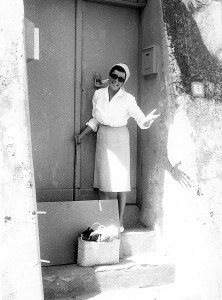
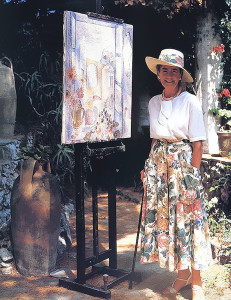
Donna Laetitia diede il suo tocco d’artista alle attività del Centro. Tutte le arti trovarono espressione – in quei trentacinque anni – tra le sale del Centro Caprense e con livelli di varietà e qualità raramente raggiungibili sull’isola. L’attenzione alla musica, alla danza, alla pittura, al teatro portò nelle sale del Centro grandi maestri, bravi artisti locali, incontri di teatro sperimentale, tutti eventi con grande successo di pubblico. Mai accantonò l’attenzione al paesaggio e ai beni culturali isolani: oltre ad ospitare la sede di Italia Nostra, promosse conferenze di archeologia, storia, scienze naturali che resero senz’altro orgogliosi Ignazio ed Edwin della loro discendente e del suo impegno nel “loro” Centro Caprense.
Non mancò di valorizzare le abilità e le operosità locali: Mare Moda Capri, le mostre di artigianato campano, quelle di pittori capresi furono solo alcune delle occasioni che fecero guadagnare al Centro Caprense e a Laetitia – l’elegante e austera contessa, colei che per indole, amicizie, ereditarietà sembrava un personaggio distante dal popolo – la stima e la gratitudine proprio di quei suoi concittadini.
Laetitia non lasciò mai più l’isola. Dal 1997 riposa a Capri, con i suoi cari, a metà strada tra il Cimitero Cattolico e quello Acattolico. E soprattutto rivive nella saletta a lei dedicata nel Centro Caprense: i suoi libri, il suo archivio, i suoi oggetti e i suoi quadri raccontano di lei quasi fosse lì seduta, sul suo sgabello altissimo, davanti al cavalletto bifacciale di zia Mabel, ad ammirare i colori di Monte Solaro mentre parla con noi.
Un variopinto manicomio
Lo zoo in piazza. Fu chiamata così la mostra di disegni allestita nel 1952 alla Canzone del Mare. Lo sguardo attento di Laetitia aveva catturato stravaganza, originalità e comicità negli habitué della piazza, quel “manicomio variopinto”, come lei amava definirlo; il suo pennino poi li aveva restituiti trasformati in animali fantastici o «corpi umani dalla testa di bestie» come insinuò Edwin. Quei disegni provano quanto le somiglianze tra padre e figlia non fossero solo caratteriali: il padre usava la penna, lei pennello e pennino. Non fu solo una questione di desinenze, ma di armi! Le descrizioni – spesso le parodie – taglienti ma nitide, ironiche ma straordinariamente vere di persone e personaggi fatte da Edwin nei suoi libri, ben si prestano ad avere come 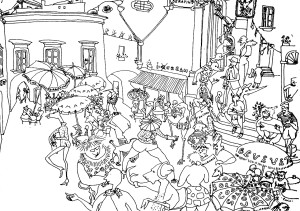 “eredi” quei disegni ad inchiostro di china di Laetitia. «Io ho il vizio di cercare l’umano nella flora, mia figlia trova la fauna nell’umano… bizzarrie di famiglia» fu la recensione di Edwin a quella mostra. | A multicoloured madhouse.Zoo in the piazza. That was the title of the exhibition of drawings held in 1952 at the Canzone del Mare. Laetitia’s penetrating gaze captured the eccentricity, originality and comic quality of the habitués of the piazza, that “multi-coloured madhouse”, as she liked to call it; her pen then transformed them into fantasy animals or “human bodies with animal heads” as Edwin suggested. Those drawings show that the similarities between the father and daughter were not simply in their personalities: the father used his writing pen, the daughter her sketching pen and brush. It was not simply a question of different tools, but of weapons! The descriptions – often parodies – sharp yet vivid, humorous but remarkably true, of people and personalities that Edwin created in his books, lent themselves very well to producing the “heirs” that appeared in Laetitia’s Indian ink drawings. “I have the bad habit of creating the human in flora, while my daughter finds the animal in the human… family quirks,” Edwin wrote in his review of the exhibition.
“eredi” quei disegni ad inchiostro di china di Laetitia. «Io ho il vizio di cercare l’umano nella flora, mia figlia trova la fauna nell’umano… bizzarrie di famiglia» fu la recensione di Edwin a quella mostra. | A multicoloured madhouse.Zoo in the piazza. That was the title of the exhibition of drawings held in 1952 at the Canzone del Mare. Laetitia’s penetrating gaze captured the eccentricity, originality and comic quality of the habitués of the piazza, that “multi-coloured madhouse”, as she liked to call it; her pen then transformed them into fantasy animals or “human bodies with animal heads” as Edwin suggested. Those drawings show that the similarities between the father and daughter were not simply in their personalities: the father used his writing pen, the daughter her sketching pen and brush. It was not simply a question of different tools, but of weapons! The descriptions – often parodies – sharp yet vivid, humorous but remarkably true, of people and personalities that Edwin created in his books, lent themselves very well to producing the “heirs” that appeared in Laetitia’s Indian ink drawings. “I have the bad habit of creating the human in flora, while my daughter finds the animal in the human… family quirks,” Edwin wrote in his review of the exhibition.
Donna Laetitia
Refined, versatile and cosmopolitan, but with deep Capri roots. She lived a long time on Capri, painting, drawing and doing petit point needlework. And above all, running the Centro Cerio, founded by her father Edwin Cerio, with whole-hearted enthusiasm
by Carmelina Fiorentino | photos Archivio F. Alvarez de Toledo
Contessa Cerio. That’s how she was introduced to me at the end of the 1980s, in the Centro Caprense Library. Her tall, slender figure, enveloped in a flowing cream-coloured silk skirt, with a ribbon made from the same silk on her straw hat and a stick with a jewelled handle, made me think straight away that that combination of refinement, aloofness and elegance must be a family trait: for that’s how the oldest Capri inhabitants remember her father Edwin.
Laetitia was born in Buenos Aires in 1908 to Edwin and Helena Hosmann, a photographer that Edwin had met in Argentina when he was working on plans for the Transandine railway for Alfred Krupp. She was very like her mother: although her complexion and hair were lighter than the “dark” Helena, her facial features strongly resembled her mother’s. She began painting and drawing as a child, under the attentive and affectionate guidance of the artists in the family, and went on to perfect her talents attending the Accademia d’Arte in Florence, taking private lessons from the well-known artist Baccio Maria Bacci, and finally attending the Art Students League in New York, as an adult.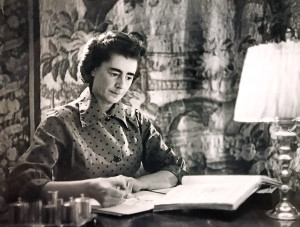
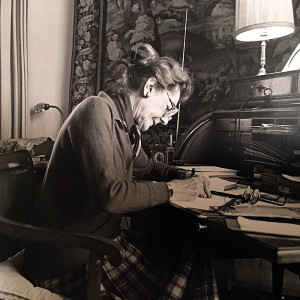
In 1932, Laetitia married Ramiro Alvarez de Toledo, the charming scion of an ancient Neapolitan family; the ceremony was held in the Salone of Palazzo Cerio, a remarkable, monumental place that preserves the memories of 700 years of celebrations and events, including royal ones. Beatrice and Fernando, the two children from their marriage, were lucky enough to have a mother who read them “home-made” fairy stories. Laetitia invented stories and, above all, illustrated them with delicate drawings of fantastic animals that grew and transformed with the turning of the pages. In Argentina, where she lived with the children during the 1940s, she was the costume designer for Pampa Film and she also designed outfits for fashion magazines.
She then went through a difficult period: the death of her beloved little Beatrice and, later, her divorce, had a profound effect on Laetitia’s mind and spirit. The affection of her friends and the protection of her earthly guardian angel, Aunt Mabel – the wife of Giorgio Cerio – enabled Laetitia to recover her strength and vitality, thanks also to her beautiful retreat: Capri.
Although the island had always played an important part in her life, from 1948 – the year in which she moved there with Fernando – Capri became even more important to her. The landscape, the colours and the characters that she came across on the island were fundamental to her becoming established as an international artist, but also to her personality. Between her studio at La Certosella – the villa in Via Tragara that her father had given her (later turned into a hotel) – and New York, Laetitia painted and sketched; she organised and arranged personal and collective exhibitions in different European cities, the USA and on Capri, in the free art room of the Centro Caprense. This was a very fertile period, artistically speaking. She designed wall paper and fabrics for various German companies, but although this was very well-remunerated, it was never her favourite activity.
Every day, summer and winter, she would go to La Canzone del Mare for a swim. It was here that she made friends with the designer Emilio Pucci – who had opened a boutique in the enchanting bay of Marina Piccola – and she began collaborating with his fashion house. Laetitia’s important friendships were not only with designers: Gracie Fields, Graham Greene, Jorge Luis Borges, Piero Gadda Conti, Francis Steegmuller and his wife Shirley Hazzard were among the Italian and foreign intellectuals who filled Laetitia’s ‘Album of friends’, along with her own spirit and intellect.
In 1962, Donna Laetitia took over as president of the Centro Caprense Ignazio Cerio after the death of its founder and president, her father Edwin Cerio, had left the non-profit organisation without a director. She had a weighty cultural, artistic and environmental legacy. Starting with her grandfather Ignazio, a well-respected doctor and modern patron of the culture and history of the island, then her father Edwin, naval engineer, humorous writer, tutelary deity of Capri and, for a short period, mayor of the island, and finally Laetitia’s aunt, Mabel Norman, all contributed to that legacy to different extents and in different ways, including through their various roles in setting up and running the Centro Caprense Ignazio Cerio non-profit organization from 1947 onwards.
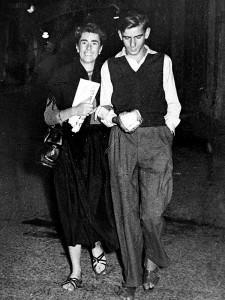
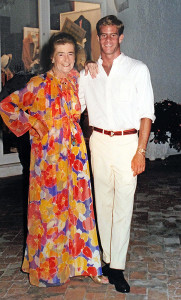 Leafing through the pages of the Libro Madre of the Centro Caprense, a set of books in which Laetitia collected invitations, photos, reviews of events as well as photos of paintings featuring the island and of characters who visited the island, the Centre and the Ca’ del Sole (her house and studio at the time), is like being catapulted back in time; but above all it helps us understand that this meticulous quality was not only typical of the Contessa who sketched or embroidered in petit point, but also of the President of the Centro Caprense.
Leafing through the pages of the Libro Madre of the Centro Caprense, a set of books in which Laetitia collected invitations, photos, reviews of events as well as photos of paintings featuring the island and of characters who visited the island, the Centre and the Ca’ del Sole (her house and studio at the time), is like being catapulted back in time; but above all it helps us understand that this meticulous quality was not only typical of the Contessa who sketched or embroidered in petit point, but also of the President of the Centro Caprense.
Donna Laetitia added her own artistic touch to the Centre’s activities. All the arts found expression in the rooms of the Centro Caprense during those thirty-five years, and at levels of variety and quality rarely achieved on the island. The attention to music, dance, painting and theatre brought great maestros, fine local artists and experimental theatre into the rooms at the Centre, and all these events were well-attended by the public. The island’s landscape and cultural heritage were not neglected either: in addition to hosting the headquarters of Italia Nostra, Laetitia organized conferences in archaeology, history and natural sciences that would undoubtedly have made Ignazio and Edwin proud of their descendant and her commitment to “their” Centro Caprense.
She never failed to make the most of local skills and industry, too: Mare Moda Capri, exhibitions of Campania handicrafts and Capri artists were just some of the occasions that earned the Centro Caprense and Laetitia – the elegant and austere contessa who, through her disposition, friendships and ancestry might appear somewhat aloof from the people – the esteem and gratitude of her co-citizens.
Laetitia never left the island again. Since 1997 she has been at rest on Capri, with her loved ones, halfway between the Catholic and Non-Catholic cemeteries. And above all she lives on in the room dedicated to her at the Centro Caprense: her books, her archive, her objects and paintings speak of her as if she were sitting there, on her high stool in front of the two-sided easel belonging to Aunt Mabel, admiring the colours of Monte Solaro as she speaks to us.
La musa di Eco Capri
Oggetti per la casa, mobili, accessori e abbigliamento. Tutto ispirato alle opere di Laetitia Cerio. È il mondo di Eco Capri, l’azienda fondata nel 2012 da Federico Alvarez de Toledo, nipote di Laetitia, che si può visitare salendo i gradini che dal “salotto di Capri” portano a piazzetta Cerio (ovviamente!) e percorrendo la galleria che conduce allo show room dove si trova un caleidoscopio di colori e forme quasi impossibile da raccontare, ma che vale la pena di andare a scoprire.
Ci sono cuscini a piccolo punto come quelli creati negli anni Ottanta da Laetitia e in cui dominano il giallo dei limoni capresi, il rosso del fuoco dell’eruzione del Vesuvio, tutte le sfumature del blu della Grotta Azzurra, e che sono declinati anche su portaocchiali, pochette, portachiavi e cinture.
Le inconfondibili silhouette dei “Piazzini” insieme ad alcuni dei suoi disegni più belli danno vita a morbide sciarpe in cachemire, grandi foulard in seta e rivestono i tessuti dei complementi di arredo, le carte da parati e i servizi per la tavola. Borse per il mare, shopper grandi e piccole e una linea di abbigliamento da uomo e da donna completano la collezione Resort. Insomma, una grande “eco” del Dna di questa eclettica donna e della sua famiglia protagonista della storia di Capri da sei generazioni.
Una donna straordinaria
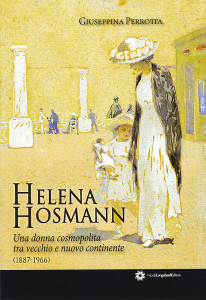 Un prezioso volume che ricostruisce la biografia di una donna vissuta a cavallo tra le due guerre, tra il Sudamerica e Capri. Il racconto accurato, appassionato e documentato di una donna moderna, artista indipendente che ha molto viaggiato con “l’occhio della fotografa” lasciandone ampia testimonianza. Moglie e madre, amante della vita, dei viaggi, dell’arte e della cultura. Tutte cose che seppe trasferire alla figlia Laetitia Cerio che di lei diceva «Mia madre mi insegnava a credere nelle cose e nella gente».| A remarkable woman.A valuable book that reconstructs the biography of a woman who lived between the two world wars, in South America and Capri. The true, passionate, documented story of a modern woman and independent artist who travelled extensively with her “photographer’s eye”, leaving plenty of evidence behind her. A wife and mother, lover of life, travel, art and culture: all things that she was able to transfer to her daughter, Laetitia Cerio, who said of her: “My mother taught me to believe in things and in people.”
Un prezioso volume che ricostruisce la biografia di una donna vissuta a cavallo tra le due guerre, tra il Sudamerica e Capri. Il racconto accurato, appassionato e documentato di una donna moderna, artista indipendente che ha molto viaggiato con “l’occhio della fotografa” lasciandone ampia testimonianza. Moglie e madre, amante della vita, dei viaggi, dell’arte e della cultura. Tutte cose che seppe trasferire alla figlia Laetitia Cerio che di lei diceva «Mia madre mi insegnava a credere nelle cose e nella gente».| A remarkable woman.A valuable book that reconstructs the biography of a woman who lived between the two world wars, in South America and Capri. The true, passionate, documented story of a modern woman and independent artist who travelled extensively with her “photographer’s eye”, leaving plenty of evidence behind her. A wife and mother, lover of life, travel, art and culture: all things that she was able to transfer to her daughter, Laetitia Cerio, who said of her: “My mother taught me to believe in things and in people.”
Tra grafica e design
Un’artista eclettica. Pittrice di valore ma, soprattutto, disegnatrice di grande talento. Alla sua opera grafica, qualche anno fa, il Centro Cerio ha voluto dedicare la mostra “Capri e il mondo nei disegni di Laetitia Cerio” di cui resta, come testimonianza, un bel catalogo che è possibile acquistare presso la segreteria del Centro. Nelle sue pagine sono racchiusi disegni noti e meno noti, da quelli della produzione come disegnatrice di moda, ai bozzetti realizzati per una ditta di tessuti e carte da parati. E poi ancora quelli pieni di poesia che hanno dato vita al libro di fiabe che Laetitia aveva inventato per i figli. Le immagini sono accompagnate dai testi di Simona D’Angiola, archivista del Centro Caprense, e Antonella Putaturo Donati Murano, docente di Storia della 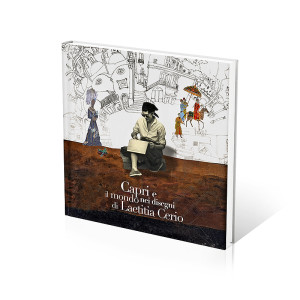 miniatura.| Between graphics and design.An eclectic artist. A first-class painter, but above all, a very talented sketcher. Some years ago, the Centro Cerio decided to devote an exhibition to her graphic work: “Capri and the world of Laetitia Cerio’s sketches”, and we still have a testimony in the form of the beautiful catalogue which can be purchased at the Centro Cerio office. Contained within its pages are well-known and less well-known drawings, from those she did as a fashion designer, to the sketches she made for a fabrics and wall paper company. And then there are the very poetic sketches in the book of fairy stories that Laetitia invented for her children. The images are accompanied by text by Simona D’Angiola, archivist at the Centro Caprense, and Antonella Putaturo Donati Murano, professor of the History of miniatures.
miniatura.| Between graphics and design.An eclectic artist. A first-class painter, but above all, a very talented sketcher. Some years ago, the Centro Cerio decided to devote an exhibition to her graphic work: “Capri and the world of Laetitia Cerio’s sketches”, and we still have a testimony in the form of the beautiful catalogue which can be purchased at the Centro Cerio office. Contained within its pages are well-known and less well-known drawings, from those she did as a fashion designer, to the sketches she made for a fabrics and wall paper company. And then there are the very poetic sketches in the book of fairy stories that Laetitia invented for her children. The images are accompanied by text by Simona D’Angiola, archivist at the Centro Caprense, and Antonella Putaturo Donati Murano, professor of the History of miniatures.
The muse of Eco Capri
Household objects, furniture, accessories and clothing. All inspired by the work of Laetitia Cerio. That’s the world of Eco Capri, the company founded in 2012 by Federico Alvarez de Toledo, Laetitia’s grandson, which can be visited by climbing the stairs from “the drawing-room of Capri” (the Piazzetta) to Piazzetta Cerio (naturally!) and walking through the gallery that leads to the show room, where you will find a kaleidoscope of colours and shapes that are almost impossible to describe, but are well worth searching out.
There are needlepoint cushions like those Laetitia made in the 1980s dominated by the yellow of Capri lemons, the fiery red of the Vesuvius eruption, and all the shades of blue of the Grotta Azzurra, also available in glasses pouches, clutch bags, key holders and belts.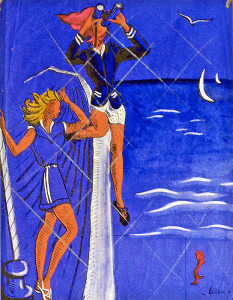
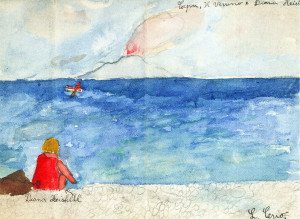
The unmistakeable silhouettes of the “Piazzini” together with some of her most beautiful drawings have been used to create soft cashmere scarves and large silk foulards, and in fabrics for homeware accessories, wall paper and tableware. Beach bags, large and small shoppers, and a line of menswear and womenswear complete the Resort collection. All in all, a deep “echo” of the DNA of this eclectic woman and her family, who have played a key role in the history of Capri for six generations.


